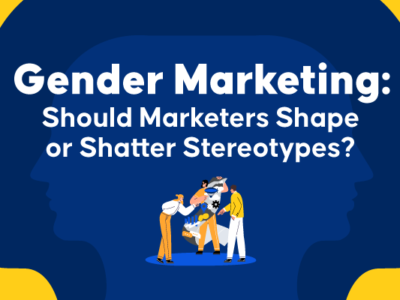Digital content is a constant presence in our lives. It’s a part of how we take in the daily news, keep in touch with friends, find answers to our questions. It’s also a key component in how businesses create and market their brand. While television advertisements, billboards and print advertisements still have their place, digital content is now front and center in most marketing strategies.
Your branding can reach more people than ever before. However, as the iconic Marvel superhero, Spiderman, once said: with great power comes great responsibility.
Creating and publishing digital content that could be construed as offensive can make or break a business. Just like in the real world, consumers want to interact with brands they relate to – they want to see their identity, values and reflected in the marketing campaigns for products they want to buy.
Diversity in digital content won’t just boost your customer base, lead generation and social media following, it will help protect your brand from taking an unexpected and potentially irreversible blow.
Cancel Culture Can Make Or Break Companies
Still not convinced problematic digital content can do damage to your brand? In 2017, Pepsi was forced to pull a television advertisement that borrowed footage from the Black Lives Matter movement. It featured footage of Kendall Jenner handing a police officer a can of Pepsi, setting off raucous approval from nearby protesters.
The advertisement was deemed highly offensive for seemingly making light of racial violence issues. Hundreds of thousands of dollars wasted, an entire marketing campaign down the drain and a permanent black mark against a household brand name.
Businesses are becoming more and more aware of the damage ‘cancel culture’ can do and are making an effort to diversify their branding. Earlier this year Dr Seuss Enterprises said it would cease printing six of its books that contained racist stereotypes. In 2020, Saputo Dairy Australia renamed Coon cheese, Cheer cheese, after a long campaign by activists who claimed the name had racist connotations.
Also Read: Buyer Personas: Content Marketing Guide
What Exactly Is Diversity And Inclusion?
The definition of diversity and inclusion can vary depending on who you ask. However, at its core, diversity and inclusion means respecting the following factors:
- Age
- Physical appearance
- Ethnicity, race or nationality
- Gender and sexuality
- Health and disabilities
- Spoken language
- Religious affiliation
- Socioeconomic status.
In nutshell, a diverse brand embraces diversity in all aspects of life and creates visual and written content that reflects that. One great example is a 2019 ad by razor company Gillette featuring a transgender teenager learning to shave for the first time with his father.
Historically speaking, Gillette’s content marketing strategy focused on selling its shaving products to cisgender men. But over time, living openly as a transgender person has become more accepted by society, and the profile of their target demographic began to shift in kind.
The ad, posted to the company’s Facebook page, was viewed over a million times and garnered a positive response both from everyday consumers and members of the LGBTQ community who said they could relate to the experience portrayed in the video. This piece of digital content is a perfect example of how a company was able to position its brand as kind, accepting, progressive and supportive.
Diversity And Brand Benefits
Diversity in digital content doesn’t just spell good news for your brand, but for your business as well. A 2019 consumer survey by Google and The Female Quotient found that respondents are more likely to consider or even purpose a product after seeing an ad they believe is diverse or inclusive.

As you can see from the results, creating content that more people can relate to means you’re reaching a wider audience and generating more leads, and more leads means more potential customers!
In addition to this, when customers see themselves represented in your digital marketing content. A person who feels seen – physically, geographically, psychologically, etc is more likely to build an emotional connection with your brand.
Sentimentality is a powerful force in the marketing world – those with an emotional connection with a brand can turn into a long term customer (the most prized of all customers).
Creating diverse digital content also grows respect and brand recognition. A recent survey by Stackla examined how both consumers and marketers perceive content in the digital age. Out of 1,590 consumers and 150 B2C marketers from the US, UK and Australia, 90% of consumers say authenticity is important when deciding which brands they like and support.
People will respect a brand that offers diverse and inclusive marketing and genuinely reflects their audience. When you as a marketer understand and speak the language of your customer, you earn their trust and even their respect.
Diverse digital content can be viewed as a kind of formula: increase audience reach + brand recognition + emotional connection = more leads, more long-term customers and a better bottom line for your business.
Diverse Content Starts With The Right Content Marketing Strategy
One of the biggest misconceptions in digital content marketing is that you have to create something for everyone. Of course, that doesn’t mean your brand can’t appeal to a wide range of people and interests. Diverse content starts with a solid content marketing strategy that’s based on research and a sound understanding of who’s drawn to your brand.
The first step is to make sure your content marketing strategy is data-driven. Google Analytics is a tried and tested method of gathering data on your customers’ age, gender and location. This is a good start, but the buyer persona of a 35-year old caucasian man buying furniture online is no longer one dimensional.
For example, this customer could be a single father, identify as non-binary or use a mobility aid – all of which is critical information. AI-powered branding tracking software such as Lantana can provide insight into customer perceptions and how they change over time. Understanding how your customers view and feel about your brand is the key to creating diverse digital content that they relate to.
Secondly, when developing a content marketing strategy, I highly recommend working with a digital marketing agency. When you’ve been in business for a while, adopting a fresh perspective can be challenging.
A team of experienced content creators is a great resource to draw upon when exploring how you introduce more diversity into your branding. It’s their job to stay on top of what consumers want to see in the digital space and how they want to see it. And as you know, cancel culture can be unforgiving, so it’s vital that you seek expert advice before moving forward with digital content creation.
Real Content For Real Customers
At the end of the day, good marketing practice requires flexibility and innovation. And as society becomes more and more accepting of people’s race, sexuality, gender identity and physical appearance, diversity in digital content is vital for the success of your brand.






